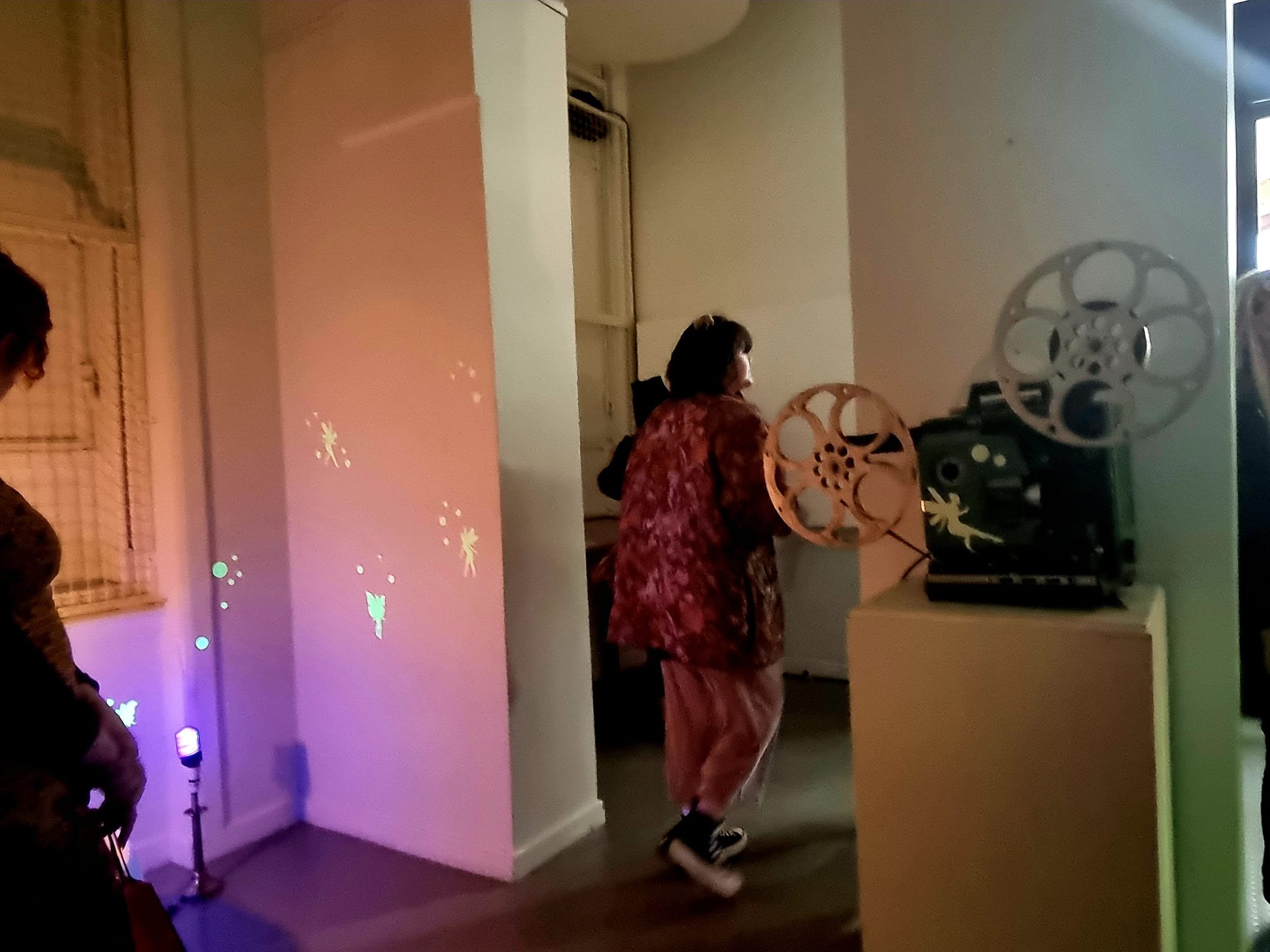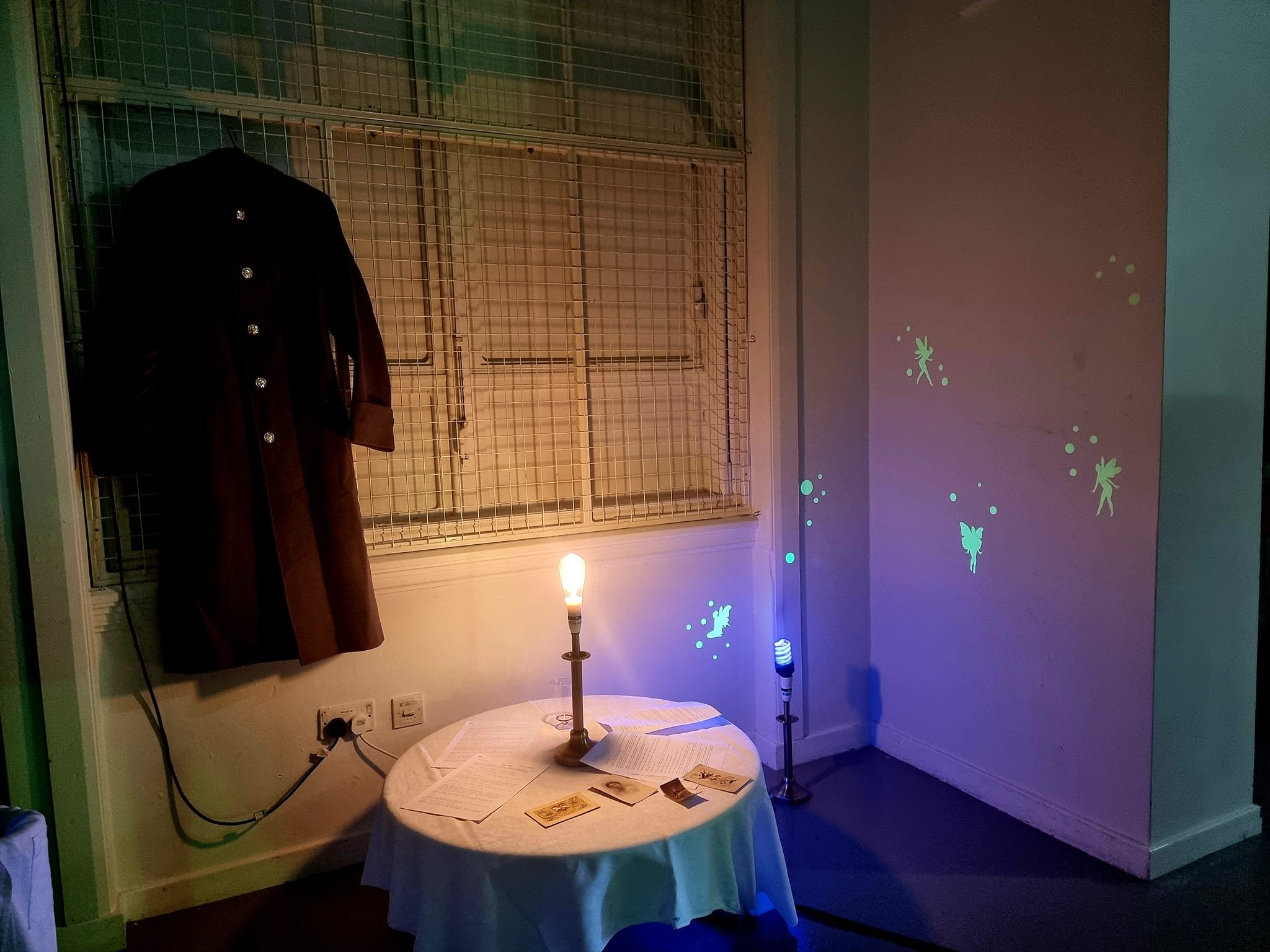FAIRY LIGHT (2022): Immersive Installation by Elizabeth Dearnley, Tamsin Dearnley, & Amy Cutler
Exhibition open from 28th May to 8th July 2022, Leeds Central Library. Info on the three collaborating artists:
Amy Cutler - Fairy Projections:
Our identification with fairies has always been through the trickery of media, even before cinema existed.
Using an existing 16mm reel of a pedagogical film (We Explore the Woodland), Amy hand-painted and modified around 200ft of film. Using tweezers, nail art, glitter, stencils, decorative tape and pink nail varnishes, she restricted herself to tools associated with the bedroom creativity of young girls. In the spirit of Frances and Elsie’s trickery, she aimed to sneak fairies into the machine of cinema – scattering their pixie dust somehow inside the mechanism itself.
The analogue film was then projected with her Bell and Howell 1695 TQ III projector and filmed flickering on a bedroom wall. It is presented here re-projected on suspended, sheer chiffon with a glimmering butterfly pattern.
A brief interlude also shows some of the public domain fairy dances of early cinema, with their slippery relationships between dancing woman, flower, butterfly, and la fée électricité (the electric fairy) - identities which can transform into each other as soon as the projection reel starts turning. Interleaving colour through the pages of the Princess Mary’s Gift Book seen in this exhibition, this section also honours the female hand-colourists who tinted, transformed and brought to life the magical effects of the male-authored films of Victorian cinema, like Flower Fairy (1905) and The Judgement of Butterflies (1906).
This film work aims to explore not just the fairies of the grassy ring, but other kinds of hidden folk: the fairies of science, electricity, and media, and the non-human presences in our archives, even if only glimmering traces on the edge of vision. It also aims to honour the power of Francis’ and Elsie’s imaginations as a precursor to today’s VR (virtual reality) and AR (augmented reality), long before the current hi-tech tools and corporate-dominated modes existed.
Fairy lights themselves were once a part of live cinema history. Invented in 1882 by Sir Joseph Swan for a performance at the Savoy Theatre, these miniature battery pack-powered lights were sewn into folds of the dresses of the lead fairies in the libretto Iolanthe, as a form of collective incandescence. The lights swarmed around each other to give a sense of the immortal revels of the banished.
Just like fairy lights – now seen merely as a stationary indoor chain of lights used as household decorations, often adorning a mantelpiece or a bed headboard – our understanding of our media has been tamed and domesticated, too.
But somewhere within it, fairies still survive.
Elizabeth Dearnley - Fairy Light Story & Set Design
In designing the set of Fairy Light, I wanted to create a reimagined version of the bedroom shared by Elsie Wright and Frances Griffiths in Cottingley during the summer of 1917. In Frances’ 2009 memoir Reflections on the Cottingley Fairies, published after her death by her daughter Christine, she describes lying in bed listening to the roaring of Cottingley Beck just outside:
Elsie and I shared her bedroom which was small, with the window only about two feet from the end of the bed. This window had no curtain, and the view in the daytime was a very good one; across the beck, up the slope, with a range of hills at the skyline. But it frightened me to death at night. A black, shiny piece of black glass, with nothing beyond but the roaring of water.
While some elements of the room are my own invention, I’ve included several objects which appear in the Cottingley fairies story, such an original copy of Princess Mary’s Gift Book, which Elsie used as the inspiration for her fairy cut-outs, watercolours by ‘Elsie’ (created by Joan Dearnley), and a stone hot water bottle which Frances describes using (having moved from South Africa earlier that year to wintry West Yorkshire, this was something of a shock to the system!).
My reimagining of the conversation between Elsie and Frances where they plan the fairy photographs is likewise part invention; we don’t know exactly what was said between the girls, although I’ve drawn on Frances’ memoir and 1980s television interviews with Elsie and Frances as older women, where they revealed how the pictures had been taken.
This is the third immersive installation I’ve created which takes place in a childhood bedroom; as a child, I loved stories about portals into other worlds such as Where The Wild Things Are, The Lion, The Witch and the Wardrobe and Through the Looking-Glass, and What Alice Found There, and I’m fascinated by the way these cosy, ordinary spaces can be transformed in the imagination into something altogether more magical.
Tamsin Dearnley - Reactive Soundscape
How it works:
A (cheap, no-frills!) camera has been installed above this exhibition. The visuals produced by this camera are then processed to a very low resolution in black and white to essentially capture only changes in movement in the room.
The data produced by the amount of movement captured is then fed through two different pieces of audio processing software:
The first translates the amount of movement captured by the camera into simple sine waves - the more movement, the higher the sine wave. These are then processed to produce the ‘ringing’ sound that is constantly changing depending on the amount of movement in the room.
The second audio feed uses the same motion detector, but this time divided into different zones of the room. Depending on where in the room the movement is detected, a randomly selected series of recorded and processed sounds will be triggered, creating an ever-shifting soundscape that is never the same twice.
Sounds you might like to listen out for:
‘Elsie and Frances’ laughing; the REAL fairy stream, recorded on location in Cottingley; Fairy bells; Harp music (playing music ‘transcribed from the fairies on Dartmoor’ in 1922); Local birdsong; Aeolian harp (the sound of the wind brushing over the strings of a harp)
The more movement is detected, the more sound there will be, so feel free to dance, move and wave your arms in the air - see what sounds you get in different parts of the room!












































































